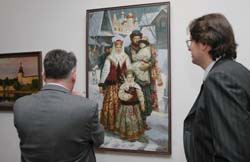Look for differences
Exhibit dedicated to the 250th anniversary of the Russian Academy of Arts
Academic art dictates its own terms. It requires the proper attitude and creates an atmosphere of emotion and large scale. It is characterized by stable images, characteristic landscapes, and recognized subjects. Kyiv art-goers now have an opportunity to experience all of this. An exhibit dedicated to the 250th anniversary of the Russian Academy of Arts opened recently at the Museum of Russian Art in Kyiv. Nearly 60 classical paintings and sculptures by graduates of the academy — our contemporaries — are on display. The exhibit was initiated by the International Association of Graduates of the Academy, which deals with the revival and development of the academic school in modern art.
Kyiv is on a list of cities where the exhibit will be introduced to the broader public. This is an event of nationwide cultural importance. According to a UNESCO resolution, the 250th anniversary of the St. Petersburg Academy of Arts is included on the list of dates marked by the world community.
Marking the 250th anniversary of the Russian Academy of Arts is a necessary action, the scholars at Kyiv’s Museum of Russian Art insist. “It is necessary in the sense that we should not break off our relations with St. Petersburg and Moscow. Ukrainians should familiarize themselves with their academic works.”
The history of the Imperial Academy of Arts, as the Russian Academy of Arts used to be called, traces its roots to the 18th century. In 1757, the patron and curator of Moscow University appealed to the Senate with a proposal to establish an academy of arts. Empress Elizabeth approved the idea, and the academy was established that year. This educational art institution was established with the goal of becoming a center for educating national artists and architects, who would eventually form the teaching staff. Among the graduates of the academy were such classical Russian painters as Vasnetsov, Briullov, and Repin, as well as individuals who contributed to Ukrainian art, working on the House of Chimeras, National Opera, and the Philharmonic Society. However, scholars insist that Ukrainian art has always differed from Russian art.
“We have always had a very strong Ukrainian school of art, particularly the Kyivan school of painting. But it is very different. This exhibit of Russian academic art is proof of this difference. The Ukrainian school is characterized by greater decorativeness and brilliance; it features more European innovations. And although our positions in art education and teaching programs are identical to those in St. Petersburg, we have our own face. Our mentality and nature produce an absolutely different result,” said an associate of the museum’s Exhibition Department.
The reactions of visitors to the exhibit were varied. Some people thought it was too “young.” “I expected to see works by the best known artists of previous centuries,” a visitor admitted. “Instead, I saw works by relatively young artists, although they are unquestionably talented.”
These reactions notwithstanding, the exposition was billed as “a presentation of contemporary artists’ works.” The show has its share of famous names. Among the exhibited artists are Zurab Tseretelli, the academy’s president, and Prof. Albert Charkin, the rector of the St. Petersburg-based Repin State Academic Institute of Painting, Sculpture, and Architecture. The scholars at the Russian museum say that the contemporary version of academic art was the main idea of the exhibit. The organizers could have shown works from the late 18th century, but they took another — more interesting — path, presenting works by some very talented contemporary artists, who chose the path of classical, not contemporary, art.
There is a mistaken view that contemporary art is the result of a person’s inability to hold a pencil and create a classical academic drawing. In fact, graduates of classical academies also deal with super-modern art. Everyone undergoes academic training. After graduating from an academy, they choose different roads: some are interested in video-art; others remain true to classical painting, while others go on to work in television.






